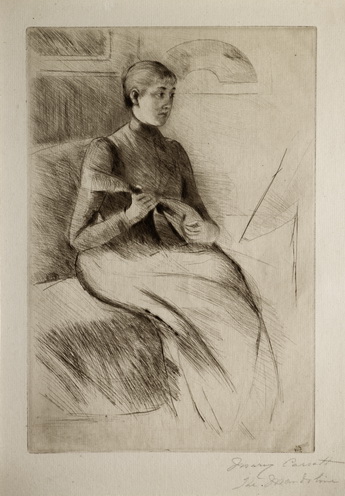Acquisition Number: 2024.16
Medium:
Drypoint on fine laid paper
Size:
9 1/8 x 6 1/8 in.
Date:
c. 1889
Credit: Gift of Tom and Ginny Horner
Cassatt's inspiration for this drypoint came from her 1872 painting of the same name - her first work accepted by the Paris Salon and her first major artistic recognition. Ironically, she used the pseudonym Mary Stevenson on the painting to hide her identity because her father disapproved of her career, telling her he'd rather see her dead than as an artist. In fact, the first painting she put her actual signature on was done in 1874. By revisiting the image of the mandolin player later in her career in this drypoint and signing her actual name on it, as well as making multiples, Cassatt was taking ownership of her success as an artist and perhaps proving to her father that it was a worthy pursuit after all.
Cassatt's paintings and prints offered a rare feminine perspective in the male-dominated art world of the late 19th and early 20th centuries, with the majority of her work portraying women and children. The mandolin player aligns with Cassatt's interest in capturing the everyday life of women. Musical performance was a common activity for women of the period, seen as an integral part of their social and cultural activities. Here a woman is engaged in the leisure activity of playing a musical instrument, the mandolin. Cassatt’s portraits won her praise from painters like Edgar Degas and Camille Pissarro, and she was the only American invited to join their Impressionist group and one of only three women formally associated with Impressionism.
Cassatt's first attempts at printmaking happened in France in 1878, where she was introduced to the medium by Edgar Degas. Printmaking became a vital aspect of Cassatt’s artistic repertoire, and she continued making etchings and lithographs, and experimenting with color. By the late 1880s, Cassatt was using drypoint almost exclusively to make her prints. In choosing drypoint she was forced to hone her drawing skills, since the direct application of the sharp, pointed tool to scratch an image on a copper plate made corrections difficult. Cassatt's controlled use of drypoint lines, leaving portions of the background unworked, gives "The Mandolin Player" the appearance of an unfinished sketch.
This image was exhibited in March, 1890, in the Exposition des Peintres-Graveurs at the Galerie Durand-Ruel, Paris, and again in November-December, 1893, in the large, comprehensive exhibition of the artist’s paintings, pastels, drawings, and prints, also at the Galerie Durand-Ruel. It is one of 12 in a series and only 25 were made; the copper plate used for printing was destroyed. Due to the nature of drypoint, where the burr which holds additional ink and gives drypoint its blurred-line effect, wears down quickly, Cassatt frequently produced her prints in limited editions. Failing eyesight severely curtailed Cassatt’s work after 1900 and she gave up printmaking in 1901. She was an exceptionally prolific printmaker, and by the time she stopped, she had produced more than 220 prints during the course of her career.
|
